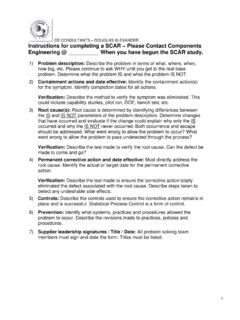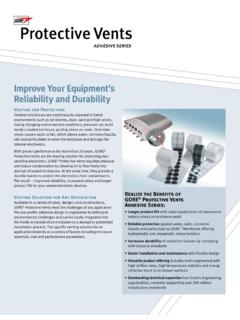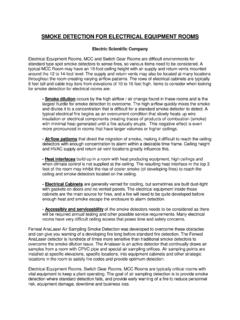Transcription of Once you know the volume of air and the static pressure of ...
1 COOLING FAN REQUIREMENTS CALCULATIONS. Determining System Impedance Determining the actual airflow produced by a fan mounted in an enclosure is much more difficult than calculating the airflow required. Obstructions in the airflow path cause static pressure within the enclosure , referred to as system impedance (expressed in static pressure as a function of flow in CFM). To maximize airflow , any resistance should be minimized, except for baffles that may be necessary to direct the airflow . A typical system impedance curve for electronic equipment follows what is called the "square law". This law states that static pressure changes as a square function of changes in the CFM.
2 The chart to the right displays typical impedance curves. static pressure through complex systems cannot be easily arrived at by calculation. The experimental method of finding airflow through an enclosure is very accurate, but costly, time consuming and cumbersome. In practice, empirical methods are normally used to estimate airflow resistance. Experience shows that: An empty enclosure usually reduces airflow by 5 to 20%. A densely packed enclosure reduces airflow by 60% or more. Most enclosures have a static pressure between and in H2O. Once you know the volume of air and the static pressure of the system to be cooled, you can determine the fan specifications for your product.
3 Required Air Flow DC or AC Power Voltage Speed Life Expectancy EMI/RFI. Heat Dissipation Auto-restart Acoustic Noise This guide will help you determine the best cooling sol for your product. Intake or Exhaust Forced air-cooling for packaged electronic enclosures can be achieved by either evacuation (with fan on exhaust side) or pressurizing the enclosure with a fan on the intake side. This choice should be made early in the design process. Although both theoretically use the same volume of air to dissipate the heat, they have different effects on placement of components within the enclosure . When using an exhaust fan, the air distribution inside the cabinet is flexible and heat from the fan itself is not dissipated into the cabinet.
4 Evacuation has the disadvantage of reducing the pressure within the enclosure , so airborne dust is drawn in through all the vents and cracks in the enclosure . Filtering of the fan on the exhaust side is extremely difficult. A further benefit is that the enclosure is slightly pressurized so that dust is not drawn into the enclosure from the surrounding environment. The disadvantage of intake fans is that filters must be changed frequently to eliminate dust accumulation. A. clogged filter can severely restrict airflow , causing elevated temperatures in an enclosure that may be more of a problem than the dust itself. Another disadvantage of a fan that pressurizes the system is that air dissipated by the fan motor can slightly warm the incoming air.
5 This can reduce the air's cooling effect. Components that have the most critical cooling requirements should be placed closest to the air inlets. High temperature components should be placed closest to the air outlets. If exclusion of dust is required, it is better to use a fan that pulls air into the enclosure . In this configuration, a filter at the fan inlet can remove dust from the incoming air. Air that is drawn into the fan flows in a continuous, non-turbulent movement called laminar flow, which allows for a uniformly distributed airflow velocity in the enclosure . This is important in eliminating stagnant air and hot spots. Air exhausted from the fan is turbulent.
6 Heat dissipation in a turbulent airflow can be up to twice that of a laminar flow with the same volumetric flow rate, except that the turbulent airflow region near a fan exhaust is normally limited. Developing a well-defined airflow path through the whole enclosure is essential to minimizing airflow waste. Vents should be at least 50 percent larger than the fan openings themselves. Care must also be taken to eliminate air re- circulation in a fan, as over ninety percent of the airflow can be lost. Baffles may be used to eliminate re-circulation of the same air since an airflow path will always take the path of least resistance (Figure Above). Subassemblies and components within the enclosure should be positioned to direct the airflow to places that require cooling.
7 Component placement should always be considered in order to take advantage of natural convection; for example, placing warm components above cool components. Avoid placing large components so that they shield smaller components from the flow of air. Use baffles, where necessary, to direct the airflow to critical hot spots. Smaller systems usually use axial cooling fans, where airflow is perpendicular to the fan blades. The airflow required to dissipate the heat generated can either be obtained by calculation or from a graph. This airflow requirement will depend on the heat generated within the enclosure and the maximum temperature rise permitted. When estimating the power dissipated within a system, use a worst-case estimate for a fully loaded system to allow for the possibility of future changes and additions of heat generating subsystems.
8 In many applications, using an intake fan rather than an exhaust fan can double or triple the life of the fan. The heated air passing over an exhaust fan stresses the fan's bearings much more than the 25 C air flowing over an intake fan. This reduction in temperature provides a dramatic increase on fan life, as seen in the JMC Life Expectancy Curve (Chart Above). Power Parameters In the past, the higher cost of DC fans led to the almost exclusive use of AC fans. Today the price differential between the two has disappeared and DC. fans have many advantages compared to AC fans. For example, DC fans typically have a longer life and consume almost 60% less power. Brushless DC fans are usually available in four nominal voltages: 5V, 12V, 24V, and 48V.
9 If the system has a regulated power supply with one of these voltages, then a brushless DC fan may be utilized. This fan will provide performance required, without the input variables that plague AC fans. The speed and airflow of a typical DC fan is proportional to the voltage supplied. Therefore, a single product may be utilized in different applications by adjusting the supply voltage to provide the desired airflow . The voltage range for satisfactory operation depends on the individual fan design. Brushless DC fans do not draw constant currents. The choice of the power source, along with the addition of other peripheral devices, will affect the type and number of DC fans and their motor current characteristics.
10 Throughout blade rotation (particularly at commutation), the current will fluctuate from minimum to maximum. The wave form and level of ripple current will vary significantly between fans and motor designs, making specifications in narrow terms difficult. An understanding of the power source limitations and how they may be impacted by various brushless DC fans early in the design phase will help prevent problems and allow maximum system flexibility. What is Locked Rotor? A locked rotor is a type of sensor output that measures when the fan has completely stopped or locked. It sends an alarm signal, at either high or low voltage when the rotor locks. If the fan starts spinning again, the alarm signal condition will stop.





